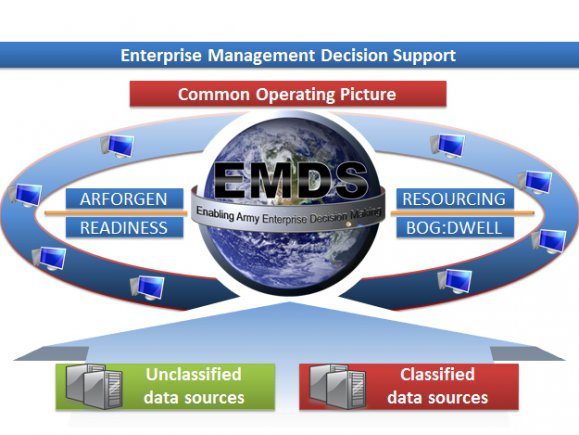For commanders and senior leaders, knowing the combat readiness status for any particular unit at any given time is basic to mission.
But getting that information hasn’t always been quick or easy, according to Lt. Col. Bobby Saxon, G-3/5/7, Department of the Army Military Operation, Force Management Enterprise division chief.
The Enterprise Management Decision Support system, or EMDS, which became operational two years ago — and will soon be getting some important upgrades — has significantly improved that process, Saxon said.
Here’s how EMDS works as explained by Saxon: First, commanders access the Secret Internet Protocol Router Network. The SIPRNet is the secure section of the Defense Department’s Internet system.
Then, commanders logon to EMDS and query the readiness levels of particular units within the Army Force Generation, or ARFORGEN, cycle. ARFORGEN is the model used to equip, train, man, activate and deploy Army forces worldwide. It is cyclical in nature, beginning with train/reset and advancing to ready, available and finally, mission execute. After deployment, the unit returns to the train/reset phase.
EMDS then takes that query and drills down into 20-some major databases across the Army associated with personnel such as rank, occupational specialty, duty status, training level and so forth; equipment readiness levels; locations of Soldiers and materiel, and so on.
A near-instantaneous, easy-to-understand response from EMDS then provides that commander the information necessary to make critical decisions. The commander could be anyone with a need to know in the active or reserve components.
“The system is extremely user-friendly,” Saxon said, adding, “the screens are designed to paint a picture of Army readiness and resources.”
Saxon said EMDS has made life much better for action officers.
“The old Force Validation Committee process required more than 40 action officers working on a regular basis to evaluate units in the Army going through transformation or preparing for mobilization or deployment,” he explained. “EMDS took the grunt work out of that.”
Force Validation Committee, or FVC, is an Army headquarters-level group that meets, as needed or directed, to review force-management levels related to mission readiness. Its findings are data intensive, relying on all aspects of manning, equipping, funding, training and so on.
As with nearly any system, improvements can always be made. The Army has been working for the past year with the Global Force Management Data Initiative to share force structure information with the rest of the services. Saxon said EMDS will likely be incorporated into that initiative. It is still in the testing and development stages.
“We’re working closely with the strategy directorate within the Army to provide links to some of the joint systems, especially the assignment and apportionment process,” Saxon said.
By 2013, EMDS will roll out new enhancements, Saxon said, such as additional metrics and data derived from drilling down even further into databases to provide leaders with a clearer and even more comprehensive picture of their forces.










